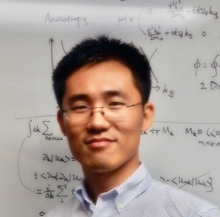ISSP Stay Report of Dr. Hua Chen
Hua Chen
Colorado State University

My 5-week visit at ISSP, starting from Nov. 11, and ending on Dec. 16, 2018, has been my longest stay in Japan. I am very grateful to Prof. Otani and Prof. Nakatsuji for creating this wonderful opportunity and for their hospitality during my stay. The research and life during the five weeks have been very memorable, which I briefly summarize below.
I got to know Prof. Nakatsuji personally at the 2016 APS March meeting, through the introduction of Dr. Tomoya Higo. The three of us sat at the hall of the Baltimore convention center for a prolonged discussion, on various topics related to noncollinear antiferromagnets, in particular Mn3Sn, which was just beginning to attract people’s attention due to their remarkable Nature paper in 2015 on the large anomalous Hall effect. In the following September Prof. Nakatsuji enthusiastically invited me to visit ISSP, which was my ever first trip to Japan and was an unforgettable experience. It was then when I first met Prof. Otani. Together with Prof. Nakatsuji, we had multiple long discussions on the prospects of spintronic applications in Mn3Sn, which I happened to do some theoretical work on before with Prof. Allan MacDonald, my postdoc adviser then. We in particular discussed the unusual magnetic-field-odd spin Hall effect (SHE) signal in single crystalline Mn3Sn observed by Dr. (now Professor at Tohoku University) Motoi Kimata at that time, which seemed to fit our theory regarding SHE as a boundary spin-density-electric-field response qualitatively. After my return to the US, together with Allan we started to fill in more details of experiment and theory, including the magnetic counterpart of the inverse SHE in Mn3Sn, and finally wrote a joint paper.
The collaboration with the colleagues at ISSP has been very enjoyable. Being among the most well known names in their respective fields, Prof. Otani and Prof. Nakatsuji introduced to me many new concepts and insights in spintronics and strongly correlated materials that I was so excited to embrace. Being a theorist, I have always been fascinated by how human perceive the physical reality through so limited protocols that we can maneuver. The discussion and collaboration with them have helped me initiate several work on the response of noncollinear antiferromagnets to external perturbations. I am also grateful to Prof. Oshikawa and Dr. Tada for many enlightening discussions during my multiple visits to ISSP.
The main purpose of my visit this time is to understand some new experimental findings from the labs of Profs. Otani, Nakatsuji, and Miwa on Mn3Sn thin films. The experiments on textured and polycrystalline Mn3Sn thin films posed many interesting questions, e.g., how different a polycrystalline noncollinear antiferromagnet is from a polycrystalline ferromagnet; how robust the symmetry arguments based on idealized single-crystalline or totally disordered structures are when applied to these intermediate thin films, etc. While many mysteries still remain, we were able to get some new understandings on the spintronic behaviors of these thin films, and had several new ideas to try both experimentally and theoretically.
The in-depth discussions with the many colleagues and friends at ISSP, including the visiting Professor Natalia Drichko, have also been very helpful to my own research. I was able to get some initial calculations done during my stay, some of which were motivated by these discussions. For example, the several hours of discussion with Prof. Nakatsuji and Dr. Higo have led to a plethora of ideas related to collinear antiferromagnets, on which I also gave a seminar at ISSP, reporting some fresh results just obtained in the same building; I was intrigued by the magnetic neutron scattering theory which I taught myself due to some email exchange with Satoru when he was visiting Johns Hopkins University, and found some unexpectedly interesting results; the discussions with Profs. Otani, Miwa and Dr. Kondou have made me understand the theory of spin-torque ferromagnetic resonance better and motivated me to think more deeply on nonlinear effects in parametric pumping. There is no doubt that my stay at ISSP will be a critical point for my research in the subsequent months, or even years.
Finally, I would like to thank Ms. Ishiguchi, Ms. Fujita, Ms. Nonogaki, and all other administrative staff who I may have missed to mention here. Your tremendous help has made this month truly enjoyable and special to my wife and me.
Thank you all, my friends at ISSP.
関連ページ
- 東京大学物性研究所 大谷研究室
- 東京大学物性研究所 中辻研究室
- 東京大学物性研究所 押川研究室
- 2019.01.17プレスリリース スピントロニクスにおける新現象「磁気スピンホール効果」の発見 -磁化で制御するスピン流−電流相互変換を確立-
